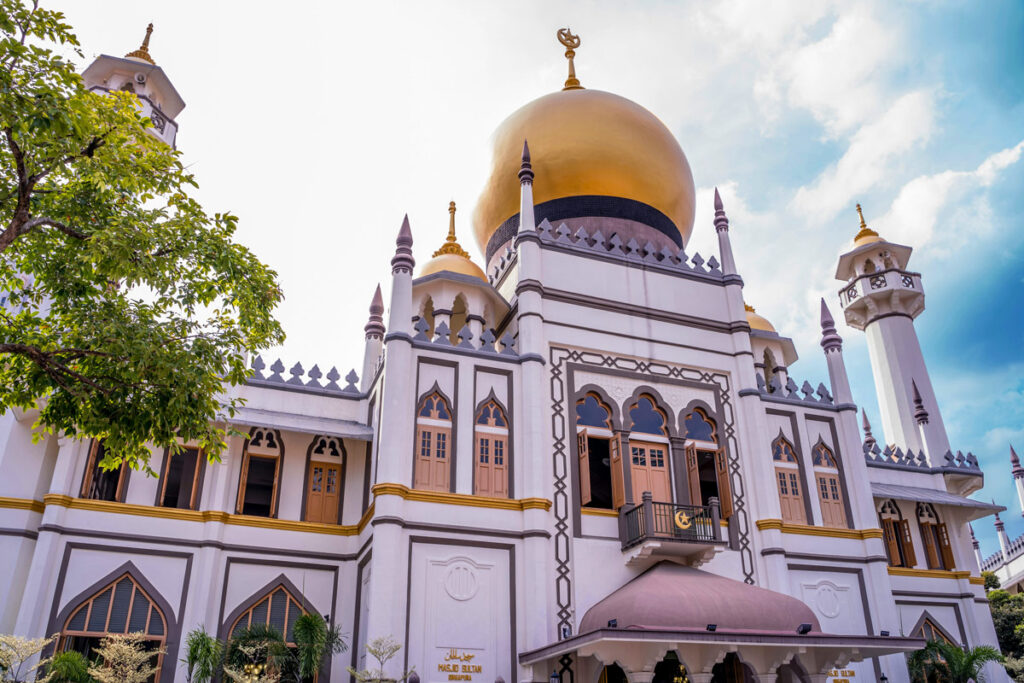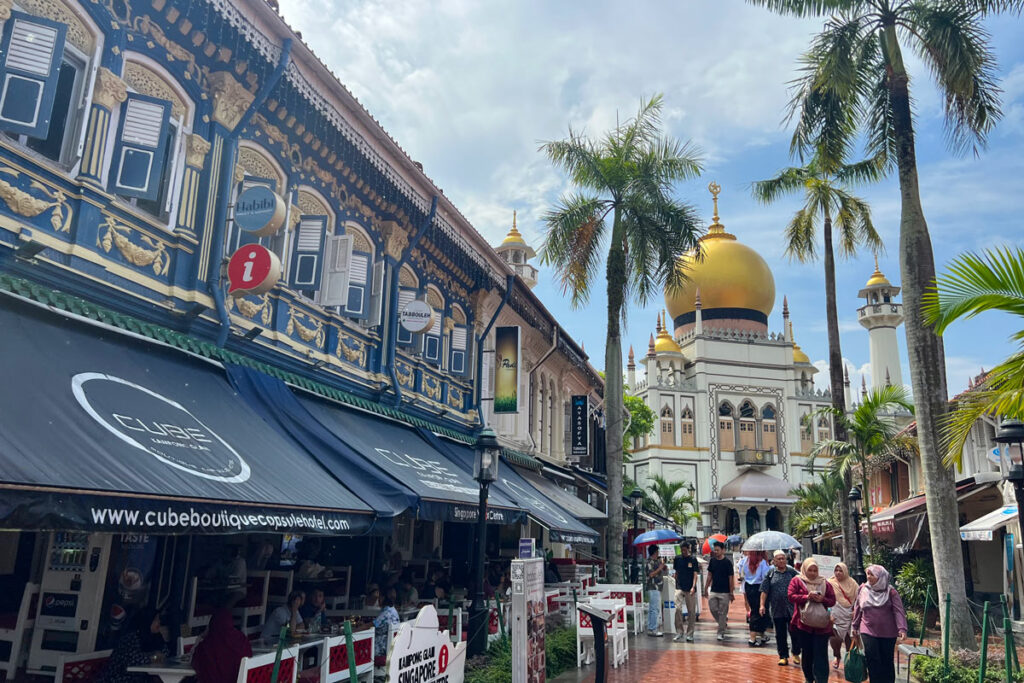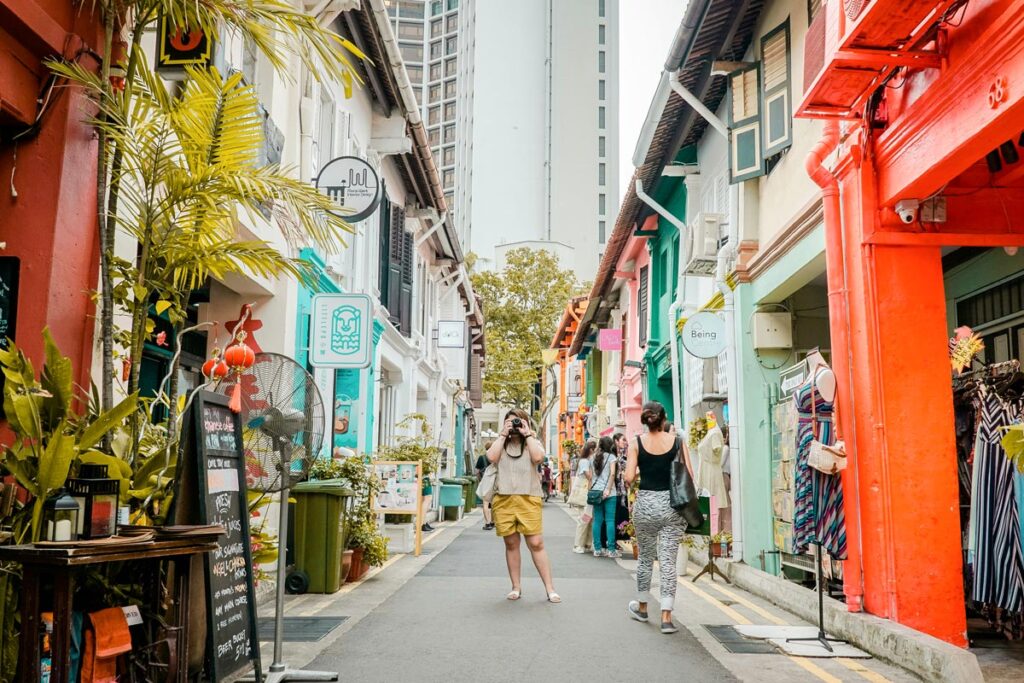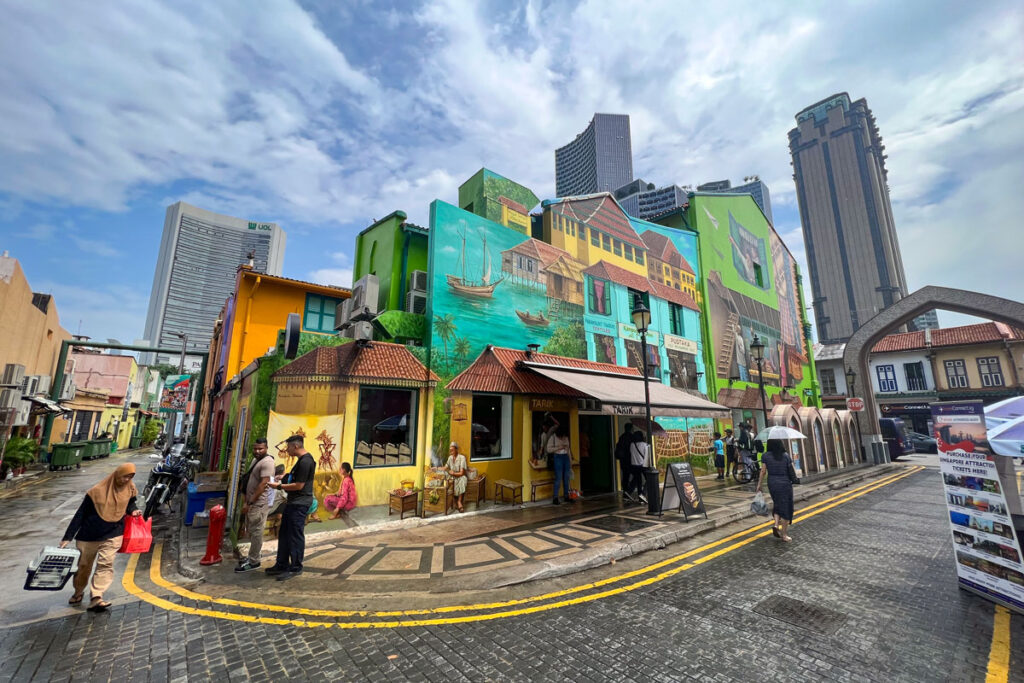Kampong Gelam is one of the oldest neighborhoods in Singapore, originally housing the city’s Malay aristocracy. Throughout its history, Kampong Gelam has always maintained a large Arab population. Today, it stands as the official ethnic quarter of Singapore’s robust Arab community. From the traditional (Sultan Mosque, Arab Street) to the trendy (Haji Lane, multitudes of vivid street art), it’s easy to pass a lively afternoon in this colorful quarter. This guide details everything to see and do in Kampong Gelam.
Jump to:
- Sultan Mosque
- Bussora Street
- Malay Heritage Centre
- Arab Street
- Haji Lane
- Kampong Gelam Street Art
- Kampong Gelam Food and Drink
Sultan Mosque

The focal point of Kampong Gelam is the grand Sultan Mosque, a palatial structure whose stately presence looms large over the surrounding streets. Originally built in 1824, it has served as the physical and symbolic anchor of the community ever since.
Visiting the mosque is free and open to the public every day, other than Fridays. Guests will receive proper cover-ups at the entrance, before enjoying a self-guided tour of the publicly-accessible areas.
Bussora Street

This pedestrian-only promenade runs perpendicular down from Sultan Mosque. For the iconic photo of Kampong Gelam, head down the street before turning and looking back up towards the mosque.
Bussora Street is primarily occupied by restaurants and cafes, who serve up tantalizing regional cuisine. We’ve spotlighted a few of the spots in the Food and Drink section below.
Malay Heritage Centre
History buffs will enjoy the Malay Heritage Centre, which was originally built as the residence of the Sultan of Singapore in 1819 before its conversion to a national monument. Ensconced in the rich architecture of the former home are six permanent exhibits detailing the history of the Malay Archipelago, as well as a series of rotating programs and workshops throughout the year.
Note: the Malay Heritage Centre is closed in 2025 for renovations. Check before you visit!
Arab Street

Arab Street is particularly popular for shopping, with local boutiques focusing on cultural goods. Here, you can purchase richly colored textiles, carpets and rugs, and even cheerful metal lanterns. A particularly unique souvenir is Sifr Aromatics, where you can blend your own customized perfume or cologne.
Haji Lane

Past Arab Street is Haji Lane, one of Singapore’s most famous streets that is renowned for its hip, indie vibe. The narrow alley, running a few city blocks in length, is packed with buzzy bars, trendy cafes, and funky boutiques. Buildings are adorned with splashy street art, which only enhances the offbeat character of Haji Lane.
Kampong Gelam Street Art

Fans of Instagrammable street art will find plenty in Kampong Gelam, where most street corners are decorated with vivid, colorful designs. A few particularly fun spots include Tarik Café (directions), Piedra Negra on Haji Lane (directions) and Mavi Turkish Restaurant (directions), on the corner of Baghdad Street and Muscat Street.
Past Mavi, continue northwest up Muscat Street, where you’ll find Gelam Gallery. Both street art and framed art coexist side by side here, which serves as the city’s first outdoor art gallery. From elaborate murals to more traditional prints, you can admire it all as you stroll the short street (directions).
For more detailed installations, you can also make your way to the Sultan Arts Village, quietly tucked away just past the Malay Heritage Center. Here, artists refine their craft on a 14-meter-long brick wall (directions), and you can watch their designs come to life as they work.
Lastly, the Aliwal Arts Centre promotes local street artists through its rotating murals. The walls surrounding the centre are regularly decked out in elaborate street art, and change every few months as a rotating gallery of sorts (directions).
Kampong Gelam Food and Drink

The food of Kampong Gelam extends beyond just regional specialties. Here, you’ll find a global melting pot of flavors. Cuisine from the Malay Peninsula, Indonesia, India and the Middle East is especially prevalent, but you’ll find everything from Japanese, Vietnamese, and Thai, to Italian, Mexican, and more represented in the quarter.
Singaporean Specialties
For traditional nasi (rice) dishes, head to either The Coconut Club or Hjh Maimunah, both of which have made the Michelin Bib gourmand list for their take on Malay rice dishes. Get the nasi lemak at The Coconut Club, or go for the nasi padang at Hjh Maimunah.
Middle Eastern Cuisine
On Bussora Street, Beirut serves up delicious Lebanese cuisine, with many of their ingredients and spices imported from the namesake city.
Another Michelin Bib Gourmand awardee is Alaturka, which earned the nod for its authentic Turkish dishes. You’ll be able to gorge on all the Middle Eastern classics: meze platters with hummus and babaganoush, falafel, halloumi, kebabs, and more. The staff will happily guide you through your order, depending on how traditional or adventurous you want to get.
International Dishes and Drinks
Singapore Zam Zam may be no-frills, but it’s also a local institution, having been around since 1908. Zam Zam is famous for its biryani, a spicy Indian rice dish that comes with meat or veggies and considered a must-try while in Singapore. The murtabak, a stuffed Indian flatbread, is also delicious here.
Rumah Makan Minang consistently gets high marks for its Indonesian comfort food staples. Dishes are simple: choose from a base of either rice or noodles, prepared in numerous ways. We’re personally always partial to the rendang.
Beyond its regional cuisine, Bussora Street is also home to Fika (ironically a Swedish café), which makes a great stop for coffee and small bites.
On Haji Lane, we particularly enjoyed Bar Stories, a comfortable, unassuming cocktail bar that has elevated mixology to works of art. They also have a full menu of bar bites and small plates.
Have more time to explore Singapore? Check out our other guides to the Lion City, including both how to spend 3 days in Singapore and the best things to do in Chinatown.
